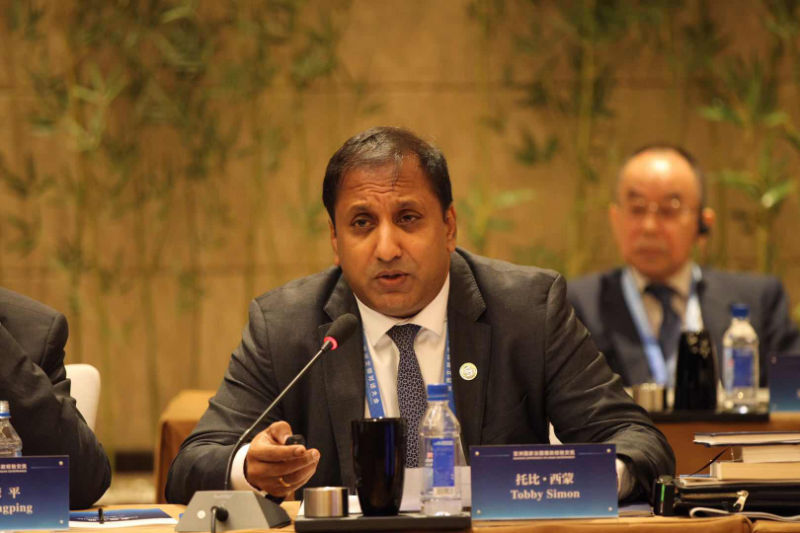Global Powershifts: Redefining Relationships in Asia
June 27, 2019 | Expert Insights
Background
The concept to “promote a sense of community of shared destiny for mankind” was first introduced at the 18th National Congress of the Communist Party of China (CPC) in November 2012. The Chinese President Xi Jinping has expounded on the notion on a number of occasions. These included a speech entitled “Working Together to Forge a New Partnership of Win-win Cooperation and Create a Community of Shared Future for Mankind” during the general debate of the 70th Session of the UN General Assembly on September 28, 2015, a keynote speech entitled “Work Together to Build a Community of Shared Future for Mankind” made at the United Nations Office in Geneva on January 18, 2017, and, more recently, his work report delivered at the 19th CPC National Congress on October 18, 2017, when “building a community with a shared future for mankind” was enshrined as one of the core concepts and basic policies guiding Chinese diplomacy in the new era.
The commitment draws inspiration from ancient Chinese philosophy regarding the relationships between diversity and unity, order and chaos, and humanity and nature. The Belt and Road initiative aims to build a community with a shared future.
Analysis
The world has moved into a new and unsettling geopolitical phase. It is not just multipolar, but multi-conceptual. There is no longer any assumption—as there had been in the post–Cold War phase, framed by so-called New World Order and Washington Consensus thinking—that norms and institutions exist towards which the world’s major powers might converge. This creates new risks and uncertainties: rising military tensions, economic and commercial disruptions, and destabilizing feedback loops between changing international relations and countries’ domestic political conditions.
At a time of geopolitical flux, re-establishing the state as the primary locus of power and legitimacy offers governments—and citizens—an increasingly attractive strategic anchor. In particular, nationalist agendas and the external projection of a strong state can be an effective strategy for governments seeking to redress perceived international humiliations, past or present. In China, for example, President Xi Jinping calls for “the great rejuvenation of the Chinese nation” to put the country’s “century of humiliation” firmly behind it. In the United States, President Trump seeks to “make America great again” after decades of being “taken advantage of.”
The guiding principles for a common destiny include:
- Inclusiveness
- Win-win
- Resolving disputes through dialogue
The Challenge
Water Stressed:
Not enough water to develop: Our analyses finds that of the HKH 8, China, India and Pakistan simply do not have sufficient water to ensure food and energy security plus develop under the current export-led economic growth model. To achieve a per capita GDP of over USD50,000, the US uses at least 1,543m3 of water/pax which is only 16% of its total renewable water resources of 9,538 m3/pax. Unfortunately, China and India are only endowed with total renewable water resources of 2,018m3/pax and 1,458m3/pax respectively; Pakistan has even less. This leaves governments no choice but to chart a roadmap to more GDP on less water and less pollution. This includes transitioning from agri- to services-led economies, controlling total water use, revamping polluting and waterintensive industries, optimising crop mix and improving efficiencies. Experiences from developed G20 countries show that trade can also be used. Europe uses less water than the US as it is largely reliant on water-intensive imports, essentially using other people’s water, whereas the US is largely food and energy secure. Regulating for water scarcity will clearly bring transitional and disruptive risks.
Cyber Security:
Today, threats to critical infrastructure are increasingly through electronic, radio-frequency or computer based attacks on the information components that control critical infrastructure. Cyber systems of critical infrastructure sectors use IT to facilitate core business processes. Critical infrastructure are therefore high-value targets for attack, as disrupting them entails extensive economic, political and social cost .
In spite of state-of-the-art security systems – such as digital signature, cryptography, biometric security, firewalls, intrusion-prevention systems and access-control systems – security breaches have increased over the years due to non-technical vulnerabilities relating to people and processes, and even closed systems are targeted and affected by viruses and worms such as Stuxnet. The weakest link in cyber security is the human being: although technical countermeasures are vital for the security of critical infrastructure, they will not be as effective without the conducive and enabling behaviour of people and processes. Cyber spies usually exploit people and process vulnerabilities.
Global Governance:
At the national level, the biggest challenge for politicians and policy makers is the need to balance the enormous benefits that global openness and connectivity brings, with national politics and priorities.
The repurposing of global governance to meet new challenges is vital. Nations are divided and cannot agree on a common approach and within nations there is no consensus or leadership on critical global issues. The number of countries now involved in negotiations and the complexity of the issues, their interconnectedness have grown rapidly, as has the effect of instant media and other pressures on politicians.
Finally, global leadership and governance in a hyper-connected world has become distributed and collaborative. We are all part of a much broader problem-solving network, with many high-performing individuals and organisations, public and private, working on different parts of different problems or on the same parts of the same problem.
Let me reiterate that governance is not about leaders charting their own course anymore. It is about helping networks solve problems with the best and most current thinking available. I feel that leaders especially in Asia must be fully aware that collaboration is the new competition, and the more valuable our contributions are, the greater our influence will be in a networked world.



Comments